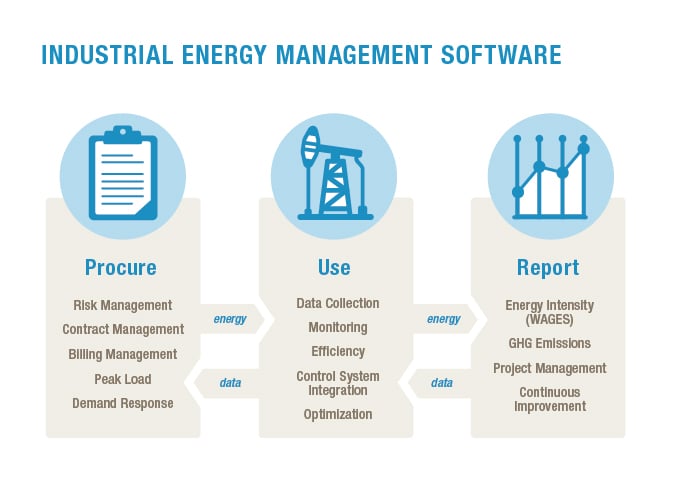The trend of high-level, enterprise goals for energy management is becoming more and more relevant today. It’s common for these goals to be publically available in an organization’s sustainability or CSR report. Additionally and increasingly frequent today, these goals may even manifest in the company mission statement or charter.
While both internal and external pressures are driving more focus on enterprise energy management, it’s still an evolving space with a number of technologies and strategies emerging. The discussion below aims to provide some insight into the main challenges organizations are facing with this as well as best practices for achieving these goals.
2 Main Roadblocks for Managing High-level Energy Goals
Unlike other industries such as retail, healthcare, education, hospitality, professional services, or municipalities, the industrial space has specific challenges with complexity and data acquisition that has hampered the management of energy at the enterprise level. There are several key challenges with this, most notably:
- Production processes and facilities are complex with the existing energy management technology and industrial automation landscape being heterogeneous. It’s typical for large industrial companies to implement point solutions for point problems, inadvertently ignoring the more holistic and long-term benefits of taking a global approach to implementations. As a result, siloed data between plants, regions, divisions, and so on requires a burdensome amount of capital to effectively decipher and analyze these disparate sources.
- Energy should be viewed as more than just an overhead cost in the industrial space. Traditionally, organizations have bundled in energy costs with other indirect costs, not delineating specific costs to specific products. By taking this approach, many opportunities for rectifying environmentally harmful and costly inefficiencies have been overlooked or not seen in a timely manner.
These two challenges tend to go hand in hand and are closely related to the difficulty organizations are facing today with collecting real-time energy data. There’s a growing need to streamline energy data from production systems into data models that can facilitate making improved energy-related and operational decisions.
Interestingly, for many of the 20-30 startup software vendors focused on the energy intelligence/efficiency space, its complexities have prompted a considerable amount to abandon the industrial space for industries with fewer technical challenges like those mentioned above.
For those startups that have stayed and for those software, automation, and energy services players that have long-established roots in the industrial space, there has been slow progress that is finally starting to gain momentum.
Operations and Procurements: A Vital Connection
While industrial organizations may set high-level goals regarding sustainability and energy, the disconnect highlighted in the section above often precludes difficulties with making measureable improvement toward them. When it comes to connecting these disparate data sources from across the enterprise, the relationship between operations and energy procurement may be the most important.
Often, this disconnect is an organizational issue, with each department working on their own initiatives and implementing their own technologies without actually communicating with one another. As a consequence, functionalities and programs that could significantly impact enterprise goals aren’t used to their full potential. These include Risk Management, Demand Response, Peak Load Management, and more.
The LNS Research IEM Framework has helped numerous organizations bridge this gap. Building on the LNS Operational Excellence Model, it helps to align and then optimize people, processes, and technology to make measureable improvements toward strategic objectives and goals. The Framework can be found here, however, not going too in depth into each section, I will provide several instrumental focus points:
- People and Leadership: Initiatives such as these often rely on buy-in from leadership for them to take hold across the enterprise. Establish a point person such as a Chief Sustainability Officer as well as a cross-functional team to lead this charge.
- Orchestrating Business Processes: Several useful programs have sprouted and become models for managing energy across business processes. Companies today are well-advised to inspect continuous improvement programs such as ISO 50001, SEP, and ENERGY STAR.
- Enterprise IT and IEM Technology: Depicted in the graphic below, the LNS Model for Industrial Energy Management Software focuses on the demand side of the industrial energy use equation. It provides a model for understanding how energy flows through the organization as well as how data must flow back through and inform decisions.

Harmonizing Operations and Procurement
Along with disparate systems and data sources, continuous improvement efforts are often siloed or do not effectively account for the broader organizational goals. It is advisable for organizations looking to bridge this gap between operations and procurement to create a cross-functional team from both sides as well as leaders in charge of continuous improvement or operational excellence programs. This can help validate that the connection is not only made, but also that it’s leveraged to its full potential.

You might also be interested in:
Enterprise Sustainability Management: A New Paradigm Emerges
Slides: Sustainable Manufacturing: Strategies for Energy Management
The Role of Reporting and Analytics in Industrial Energy